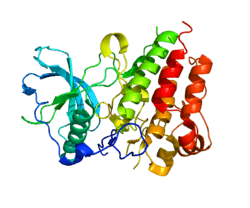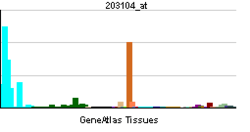Colony stimulating factor 1 receptor
| View/Edit Human | View/Edit Mouse |
Colony stimulating factor 1 receptor (CSF1R), also known as macrophage colony-stimulating factor receptor (M-CSFR), and CD115 (Cluster of Differentiation 115), is a cell-surface protein encoded, in humans, by the CSF1R gene.[4][5] It is a receptor for a cytokine called colony stimulating factor 1.
Genomics
The gene is located on long arm of chromosome 5 (5q32) on the Crick (minus) strand. It is 60.002 kilobases in length. The encoded protein has 972 amino acids and a predicted molecular weight of 107.984 kiloDaltons. The first intron of the CSF1R gene contains a transcriptionally inactive ribosomal protein L7 processed pseudogene, oriented in the opposite direction to the CSF1R gene.[4]
Function
The encoded protein is a single pass type I membrane protein and acts as the receptor for colony stimulating factor 1, a cytokine which controls the production, differentiation, and function of macrophages. This receptor mediates most, if not all, of the biological effects of this cytokine. Ligand binding activates CSF1R through a process of oligomerization and trans-phosphorylation. The encoded protein is a tyrosine kinase transmembrane receptor and member of the CSF1/PDGF receptor family of tyrosine-protein kinases. A structure of the autophosphorylation complex of Y561 in the juxtamembrane region of CSF1R has been identified[6] in Protein Data Bank entry 3LCD.[7]
The structure of the autophosphorylation of a tyrosine residue in the N-terminal juxtamembrane region (Tyr561) has been identified in PDB entry 3LCD.[8]
Clinical significance
Mutations in CSF1R are associated with chronic myelomonocytic leukemia and type M4 acute myeloblastic leukemia.[9] Increased levels of CSF1R1 are found in microglia in Alzheimer's disease and after brain injuries. The increased receptor expression causes microglia to become more active.[10] Both CSF1R, and its ligand colony stimulating factor 1 play an important role in the development of the mammary gland and may be involved in the process of mammary gland carcinogenesis.[11][12][13] Mutations in the tyrosine kinase domain have been associated with hereditary diffuse leukoencephalopathy with spheroids.
Interactions
Colony stimulating factor 1 receptor has been shown to interact with:
- Cbl gene,[14]
- FYN,[15]
- Grb2,[16]
- Suppressor of cytokine signaling 1,[17] This receptor is also linked with the cells of MPS.
See also
References
- ↑ "Drugs that physically interact with Macrophage colony-stimulating factor 1 receptor view/edit references on wikidata".
- ↑ "Human PubMed Reference:".
- ↑ "Mouse PubMed Reference:".
- 1 2 EntrezGene 1436
- ↑ Galland F, Stefanova M, Lafage M, Birnbaum D (1992). "Localization of the 5' end of the MCF2 oncogene to human chromosome 15q15→q23". Cytogenet. Cell Genet. 60 (2): 114–6. doi:10.1159/000133316. PMID 1611909.
- ↑ Xu, Q.; Malecka, K. L.; Fink, L.; Jordan, E. J.; Duffy, E.; Kolander, S.; Peterson, J. R.; Dunbrack, R. L. (1 December 2015). "Identifying three-dimensional structures of autophosphorylation complexes in crystals of protein kinases". Science Signaling. 8 (405): rs13. doi:10.1126/scisignal.aaa6711. PMID 26628682.
- ↑ Meyers, Marvin J.; Pelc, Matthew; Kamtekar, Satwik; Day, Jacqueline; Poda, Gennadiy I.; Hall, Molly K.; Michener, Marshall L.; Reitz, Beverly A.; Mathis, Karl J.; Pierce, Betsy S.; Parikh, Mihir D.; Mischke, Deborah A.; Long, Scott A.; Parlow, John J.; Anderson, David R.; Thorarensen, Atli (March 2010). "Structure-based drug design enables conversion of a DFG-in binding CSF-1R kinase inhibitor to a DFG-out binding mode". Bioorganic & Medicinal Chemistry Letters. 20 (5): 1543–1547. doi:10.1016/j.bmcl.2010.01.078. PMID 20137931.
- ↑ Xu, Q; Malecka, KL; Fink, L; Jordan, EJ; Duffy, E; Kolander, S; Peterson, JR; Dunbrack RL, Jr (1 December 2015). "Identifying three-dimensional structures of autophosphorylation complexes in crystals of protein kinases.". Science signaling. 8 (405): rs13. doi:10.1126/scisignal.aaa6711. PMID 26628682.
- ↑ Ridge SA, Worwood M, Oscier D, Jacobs A, Padua RA (February 1990). "FMS mutations in myelodysplastic, leukemic, and normal subjects". Proc. Natl. Acad. Sci. U.S.A. 87 (4): 1377–80. doi:10.1073/pnas.87.4.1377. JSTOR 2353838. PMC 53478
 . PMID 2406720.
. PMID 2406720. - ↑ Mitrasinovic OM, Grattan A, Robinson CC, Lapustea NB, Poon C, Ryan H, Phong C, Murphy GM (April 2005). "Microglia overexpressing the macrophage colony-stimulating factor receptor are neuroprotective in a microglial-hippocampal organotypic coculture system". J. Neurosci. 25 (17): 4442–51. doi:10.1523/JNEUROSCI.0514-05.2005. PMID 15858070.
- ↑ Tamimi RM, Brugge JS, Freedman ML, Miron A, Iglehart JD, Colditz GA, Hankinson SE (January 2008). "Circulating colony stimulating factor-1 and breast cancer risk". Cancer Res. 68 (1): 18–21. doi:10.1158/0008-5472.CAN-07-3234. PMC 2821592
 . PMID 18172291.
. PMID 18172291. - ↑ Pollard JW, Hennighausen L (September 1994). "Colony stimulating factor 1 is required for mammary gland development during pregnancy". Proc. Natl. Acad. Sci. U.S.A. 91 (20): 9312–6. doi:10.1073/pnas.91.20.9312. PMC 44802
 . PMID 7937762.
. PMID 7937762. - ↑ Sapi E (January 2004). "The role of CSF-1 in normal physiology of mammary gland and breast cancer: an update". Exp. Biol. Med. (Maywood). 229 (1): 1–11. PMID 14709771.
- ↑ Mancini A, Koch A, Wilms R, Tamura T (April 2002). "c-Cbl associates directly with the C-terminal tail of the receptor for the macrophage colony-stimulating factor, c-Fms, and down-modulates this receptor but not the viral oncogene v-Fms". J. Biol. Chem. 277 (17): 14635–40. doi:10.1074/jbc.M109214200. PMID 11847211.
- ↑ Courtneidge SA, Dhand R, Pilat D, Twamley GM, Waterfield MD, Roussel MF (March 1993). "Activation of Src family kinases by colony stimulating factor-1, and their association with its receptor". EMBO J. 12 (3): 943–50. PMC 413295
 . PMID 7681396.
. PMID 7681396. - ↑ Mancini A, Niedenthal R, Joos H, Koch A, Trouliaris S, Niemann H, Tamura T (September 1997). "Identification of a second Grb2 binding site in the v-Fms tyrosine kinase". Oncogene. 15 (13): 1565–72. doi:10.1038/sj.onc.1201518. PMID 9380408.
- ↑ Bourette RP, De Sepulveda P, Arnaud S, Dubreuil P, Rottapel R, Mouchiroud G (June 2001). "Suppressor of cytokine signaling 1 interacts with the macrophage colony-stimulating factor receptor and negatively regulates its proliferation signal". J. Biol. Chem. 276 (25): 22133–9. doi:10.1074/jbc.M101878200. PMID 11297560.
Further reading
- Rettenmier CW, Roussel MF, Sherr CJ (1988). "The colony-stimulating factor 1 (CSF-1) receptor (c-fms proto-oncogene product) and its ligand". J. Cell Sci. Suppl. 9: 27–44. PMID 2978516.
- Stanley ER, Berg KL, Einstein DB, Lee PS, Pixley FJ, Wang Y, Yeung YG (January 1997). "Biology and action of colony--stimulating factor-1". Mol. Reprod. Dev. 46 (1): 4–10. doi:10.1002/(SICI)1098-2795(199701)46:1<4::AID-MRD2>3.0.CO;2-V. PMID 8981357.
- Gout I, Dhand R, Panayotou G, Fry MJ, Hiles I, Otsu M, Waterfield MD (December 1992). "Expression and characterization of the p85 subunit of the phosphatidylinositol 3-kinase complex and a related p85 beta protein by using the baculovirus expression system". Biochem. J. 288 (2): 395–405. doi:10.1042/bj2880395. PMC 1132024
 . PMID 1334406.
. PMID 1334406. - Boultwood J, Rack K, Kelly S, Madden J, Sakaguchi AY, Wang LM, Oscier DG, Buckle VJ, Wainscoat JS (July 1991). "Loss of both CSF1R (FMS) alleles in patients with myelodysplasia and a chromosome 5 deletion". Proc. Natl. Acad. Sci. U.S.A. 88 (14): 6176–80. doi:10.1073/pnas.88.14.6176. PMC 52045
 . PMID 1829836.
. PMID 1829836. - Roussel MF, Cleveland JL, Shurtleff SA, Sherr CJ (September 1991). "Myc rescue of a mutant CSF-1 receptor impaired in mitogenic signalling". Nature. 353 (6342): 361–3. doi:10.1038/353361a0. PMID 1833648.
- Reedijk M, Liu XQ, Pawson T (November 1990). "Interactions of phosphatidylinositol kinase, GTPase-activating protein (GAP), and GAP-associated proteins with the colony-stimulating factor 1 receptor". Mol. Cell. Biol. 10 (11): 5601–8. PMC 361316
 . PMID 2172781.
. PMID 2172781. - Sherr CJ, Rettenmier CW, Sacca R, Roussel MF, Look AT, Stanley ER (July 1985). "The c-fms proto-oncogene product is related to the receptor for the mononuclear phagocyte growth factor, CSF-1". Cell. 41 (3): 665–76. doi:10.1016/S0092-8674(85)80047-7. PMID 2408759.
- Coussens L, Van Beveren C, Smith D, Chen E, Mitchell RL, Isacke CM, Verma IM, Ullrich A (1986). "Structural alteration of viral homologue of receptor proto-oncogene fms at carboxyl terminus". Nature. 320 (6059): 277–80. doi:10.1038/320277a0. PMID 2421165.
- Hampe A, Shamoon BM, Gobet M, Sherr CJ, Galibert F (1989). "Nucleotide sequence and structural organization of the human FMS proto-oncogene". Oncogene Res. 4 (1): 9–17. PMID 2524025.
- Visvader J, Verma IM (March 1989). "Differential transcription of exon 1 of the human c-fms gene in placental trophoblasts and monocytes". Mol. Cell. Biol. 9 (3): 1336–41. PMC 362728
 . PMID 2524648.
. PMID 2524648. - Roberts WM, Look AT, Roussel MF, Sherr CJ (November 1988). "Tandem linkage of human CSF-1 receptor (c-fms) and PDGF receptor genes". Cell. 55 (4): 655–61. doi:10.1016/0092-8674(88)90224-3. PMID 2846185.
- Xu DQ, Guilhot S, Galibert F (May 1985). "Restriction fragment length polymorphism of the human c-fms gene". Proc. Natl. Acad. Sci. U.S.A. 82 (9): 2862–5. doi:10.1073/pnas.82.9.2862. JSTOR 25278. PMC 397666
 . PMID 2986142.
. PMID 2986142. - Sherr CJ, Rettenmier CW (1986). "The fms gene and the CSF-1 receptor". Cancer Surv. 5 (2): 221–32. PMID 3022923.
- Le Beau MM, Westbrook CA, Diaz MO, Larson RA, Rowley JD, Gasson JC, Golde DW, Sherr CJ (February 1986). "Evidence for the involvement of GM-CSF and FMS in the deletion (5q) in myeloid disorders". Science. 231 (4741): 984–7. doi:10.1126/science.3484837. PMID 3484837.
- Wheeler EF, Roussel MF, Hampe A, Walker MH, Fried VA, Look AT, Rettenmier CW, Sherr CJ (August 1986). "The amino-terminal domain of the v-fms oncogene product includes a functional signal peptide that directs synthesis of a transforming glycoprotein in the absence of feline leukemia virus gag sequences". J. Virol. 59 (2): 224–33. PMC 253070
 . PMID 3525854.
. PMID 3525854. - Verbeek JS, Roebroek AJ, van den Ouweland AM, Bloemers HP, Van de Ven WJ (February 1985). "Human c-fms proto-oncogene: comparative analysis with an abnormal allele". Mol. Cell. Biol. 5 (2): 422–6. PMC 366728
 . PMID 3974576.
. PMID 3974576. - Lee AW, Nienhuis AW (September 1990). "Mechanism of kinase activation in the receptor for colony-stimulating factor 1". Proc. Natl. Acad. Sci. U.S.A. 87 (18): 7270–4. doi:10.1073/pnas.87.18.7270. PMC 54725
 . PMID 2169623.
. PMID 2169623.
External links
- CSF1R protein, human at the US National Library of Medicine Medical Subject Headings (MeSH)
This article incorporates text from the United States National Library of Medicine, which is in the public domain.

